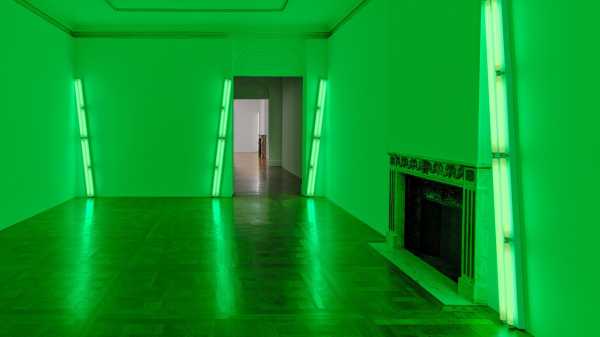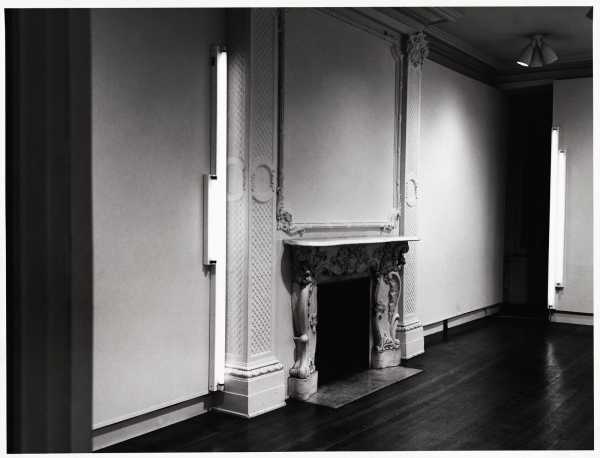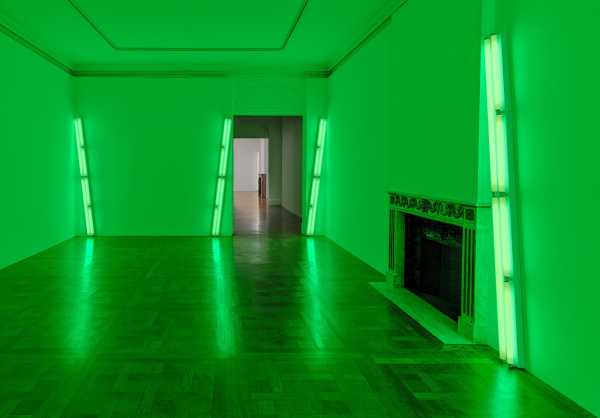
In 1963, Dan Flavin made his breakthrough work of fluorescent-light art, and for the rest of his life he stuck with what he knew. Can you blame him? After a few years of messing around with various media, he’d found a golden ticket. His fluorescents massaged the mind but never forgot to delight the eyes. In the same breath, they flattered rival ideas of art: candy-colored Pop, terse Minimalism, conceptual abracadabra. Not everyone loved these works—which, when arranged in their stipulated spaces, he called situations—but most of what his detractors said could be answered with a triumphant “That’s the point!” His cunningly modest definitions of success made conspicuous failure almost impossible. That’s no small thing, even if you happen to agree with me that Flavin’s situations are strong evidence that failure in art is underrated.
He was born in 1933 in Jamaica, Queens, and studied to become a priest. Altars, crosses, and stained glass seem relevant to a career defined by colorful glowing totems, but Flavin could be coy about the Catholic roots of his work, as he was about most labels—like his close friend Donald Judd, he disliked the term “Minimalism,” though the more he struggled the tighter it seemed to stick. Photographs show a round, sturdy-jawed, tough yet cheerful young man, his eyes smiling even when his mouth isn’t. Faces aren’t manifestos, but there’s a little of Flavin’s appearance in his art: the same intimidating rigor found in other avant-gardists of the era, but with more of a twinkle. When the artist Mel Bochner chose a movie star to play Flavin in a hypothetical “Minimal Art–The Movie,” he went with Jackie Gleason.
Few artists made such a gleaming weapon of banality. From the start, Flavin opted for tube-shaped, commercially available fluorescent lamps, the kind that invaded American office buildings during the Second World War, and the commonness of the material is part of his work’s peculiar flavor. At the David Zwirner gallery on the Upper East Side, two rooms have been outfitted with lights—cool white verticals in one, iris-stinging green diagonals in the other—to re-create two Flavin exhibitions from 1967, both held at Kornblee Gallery. The simplicity of the arrangements (one four-foot-long tube on top of another, eight-footers beside six- and two-footers, etc.) draws attention to details; as I walked through, I noticed the tubes’ chipped black labels and the screws and bolts holding the scuffed metal mounts to the walls. What comes out of the tubes has some of the same messy sparseness: if James Turrell transfigures galleries by sculpting with light, Flavin scribbles with it. His colors fill rooms, but not to the brim. The floors and walls at Zwirner remain themselves, even after they’ve been marked up with his thin graffiti of green and white.
When asked about analogies between fluorescent art and drawing, Flavin objected. No surprise there: he objected to most interpretations of his work, including his. The way he described his art—“It is what it is, and it ain’t nothing else”—could be Minimalism’s motto, and it pleased him to think that art in general was “shedding its vaunted mystery for a common sense of keenly realized decoration.” In his interviews and writings, “mystery” and “mysticism” are boogeymen who show up from time to time to menace the handsome heroes, the literal and the commonsensical. But he wasn’t above flirting with the enemy—“I can take the ordinary lamp out of use,” he wrote, “and into a magic that touches ancient mysteries.” Early on, he described his creations as “blank magic,” a phrase that he never fully explained but that hints at a little mysticism stuck to the bottom of his cup.
How could there not be, when we’re talking about light, one of the most mystical things known to humankind? The trick with Flavin’s situations—the reason they’re minimalist art for people who aren’t quite sure if they like Minimalism—is that they mean exactly what they are but plainly mean something more. Before he took up fluorescents, Flavin embarked on a series of art works that he called icons, and the title would have worked well for the situations, too: they’re icons from which all the sacred content and almost all the sacred aura has been sapped, art in which the worldly and the otherworldly are left to squabble like an old married couple.

Art work by Dan Flavin / Photograph by Kerry McFate / Courtesy David Zwirner
It’s easy to be taken with Flavin’s situations—how spare they are, and how much thought and feeling they smuggle in anyway—and still get tired of them quickly. This might actually be what Flavin wanted, at least at first. In the December, 1967, edition of Artforum, a copy of which appears in a vitrine at the Zwirner show, he wrote, “I intend rapid comprehensions—get in and get out situations,” yet for the next twenty-nine years he kept making it harder for viewers to heed his advice. In some of his later work, fluorescent lights leave the walls and take over the center of the room; in others, they arc or crisscross prettily, but there were only so many ways he could reshuffle the deck. His commissions got showier and higher-budgeted—churches, Grand Central Terminal, the Guggenheim rotunda—without necessarily getting more piquant.
It’s a shame, because the early situations are often funny in a dry, noncommittal way that doesn’t strain too hard to impress. I enjoyed the show at Zwirner more than almost any of the later, larger Flavins I’ve encountered: the tubes almost seem to look around, taking in the windows, the plain walls, the wooden parquet floors, and the marble fireplaces, and then to shrug, opting out of their rooms’ prim fanciness. Though the light throws everything into question, nothing is really asserted in its place. In contrast with the original Kornblee exhibitions, held near the beginning and end of 1967, Zwirner’s remake puts its two Flavins side by side—look at the green fluorescents long enough, and the whites turn magenta. It’s one of the most satisfying things about the show, though the optical illusion begins to fade the second you look away. Just as nothing is asserted here, nothing lasts forever.
Which raises the question: Why bring back a pair of exhibitions from more than half a century ago? Revivals aren’t rare in New York—last year, Zwirner coörganized one for Diane Arbus’s 1972 MoMA retrospective—but why Flavin? A partial answer might be to give us a peek behind the scenes, revealing how much fussing and haggling were needed to realize a straightforward-seeming product. As the vitrine demonstrates, Flavin made preparatory drawings for his Kornblee show, complete with furious, almost illegible notes. Other bits of backstage intrigue, not alluded to at Zwirner, can seem richer than the feature attraction. “In time the whole electrical system will pass into inactive history,” Flavin wrote in his journal in 1962. “My lamps will no longer be operative.” In the eighties, when the Sylvania lighting company briefly stopped manufacturing green fluorescents, he was forced to buy up hundreds of them in order to stave off a blackout. The mini-crisis was averted (by which time his assistant had a collection of more than six hundred spares), but the real crisis remained: eventually, Flavin’s fluorescent tubes wouldn’t be available over the counter. Today, his estate helps supply galleries with fresh ones, built by a custom fabricator, and, if someone can verify that a burnt-out light came from a Flavin show, it might sell for a small fortune.
It’s a tasty irony that, in emphasizing the accessibility and plainness of his materials, Flavin ended up hoarding them like Romanov diamonds and relying on a team of semi-artisanal specialists—so tasty that I wish he’d mixed it into his art instead of burying it in his diaries. But, even if fluorescent manufacture has changed, fluorescent light itself hasn’t, and this gives the situations at Zwirner a paradoxical allure that fully justifies their revival. It is curious to walk through the two rooms and consider that we’re now as far removed from 1967 as 1967 was from 1911, when a good portion of the U.S. was lit by kerosene and cow fat. After all this time, cool white light is still cool white light, illuminating schools and hospitals and waiting rooms from sea to shining sea. There’s something mystical about that: an aura of pure, ordinary stillness that Flavin couldn’t have predicted, but that almost seems like the thing he was chasing. If it’s not blank magic, what is? ♦

Art work by Dan Flavin / Photograph by Kerry McFate / Courtesy David Zwirner
Sourse: newyorker.com






